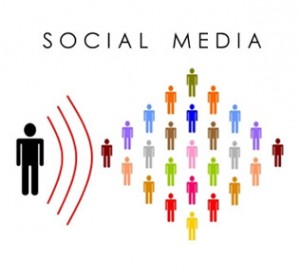Beware, it’s a LONG post, but it has practical advice for social media success.
The success of the social media space just now is in its power to create customers who create customers. This should be the purpose of most sustainable business models. We used to call it word of mouth, now we call it social media.
Because of this, digital marketing rhetoric is evolving. Now we say “If content is king then distribution is god almighty.” Social Media creates an almost infinite distribution channel for our content, if it is engaging enough to share.
Think of the Kony campaign from March 2012.
But because of the potential of social media, many brands are dabbling in it to some extent and in my opinion, many businesses are jumping in feet first without considering the medium, the end user and the implications for their brand.
On the surface, social media is really easy to do. All you need is a promotion, a website to link through to and someone to post updates a few times a day, right? No, not right.
Because of this cavalier attitude towards social media, Facebook, Twitter and YouTube are full of corporate profiles with either no fans and no engagement or lots of fans, lured in by the brand they love or through Facebook advertising and still no real engagement once a promotional campaign has ended. There are some businesses that are successfully using social media profiles as a customer service channel to manage complaints and questions. This is a smart move because those complaints or conversations will be happening anyway, by addressing them in an open forum they can be seen as being open and honest and helpful – this is a smart risk management & customer retention strategy.
What Brands are doing social media well?
Of course there are exceptions to this broad sweeping statement I’ve made above. Jessica Michaels, the found of BreadNButter Digital – a consultancy who specialise in Social Media Marketing, believes that Go Pro is the brand with the most engaging social media community at the moment. From looking at their Facebook profile they certainly have a lot of fans and are getting hundreds of comments, shares and likes on images and posts.
My own experience at WWF-Australia, where I did a lot of competitive analysis of other not-for-profit’s social media profiles, proved that when people believe in a cause they are very vocal and as a result the WWF, Greenpeace and other environmental organisations all tend to enjoy high participation rates and often very robust conversations between users as well as between WWF staff and supporters.
Canon’s World of EOS is another engaged community but most of the activity is housed within Canon’s World of EOS website where photographers can login and use video tutorials from celebrated photographers to help improve their craft. They can take up challenges and enter competitions where other community members and the general public can vote and the winners get published as part of Canon’s outdoor advertising campaign. However Canon’s EOS Facebook page is a perfect example of how social media must be maintained because since the World of EOS campaign finished in November 2011, there has been very little engagement or activity on their profile page. This is a terrible brand experience and a real slap in the face to the 85,000+ people who liked the page and participated and how now effectively been dropped – until the campaign picks up again next year and they’ll be expected to jump back on board.
I won’t talk about the Obama 2009 Presidential campaign because its been referenced to death – but it is one of the primary reasons why social media has gone mainstream and many credit it with Obama’s ability to cut through and become America’s first African American President.
Now I’ll get into the nitty- gritty details and practical steps to take that small businesses and non-digital marketers really want to know.
To have a successful social media strategy…
1. You Cannot Run Social Media As A Campaign With A Start & End Date
– Social media is a commitment, not a campaign. Social media is out there on a permanent basis so you can’t just ignore it when your campaign has finished, you have a responsibility to your engaged audience. For success, you have to have a long term strategy. Generally what happens is that once your campaign has ended, the interaction becomes zero, as it did for Canon. It’s not a good look to have a Facebook page that shows up in search results and then when a user clicks through there has been no activity for weeks or months.
– There is no mandatory checklist for social media because there are so many social media sites and many other ways to integrate social into your websites as well as your offline marketing and events.
However, I would recommend to start with a benchmark report of your key competitors and look for gaps that will opportunities – and of course, watch out for what challenges they have faced so you can be prepared. I would also suggest that your business invests in a structured approach to social media. This means mapping out the themes you plan to talk about and have your social media content schedule in place.
2. You Have To Energize The Conversation From Time To Time
– Social media is not a set and forget marketing initiative where you can create the space and expect people to come and talk among themselves.
– To be truly engaging and encourage participation, your social media content, and its author, need to be real (and available is even better). An authentic and sincere individual who is identifiable and really wants to engage with people and change their lives (for the better).
This is important as it will make a real person accountable to your community and they will be able to ensure that your business keeps the promises you make to the consumer.
– Your business needs to invest in a Content Marketing Lead – engaging and moderating social communities is a skill and a passion. Most businesses just add it as a new task to an existing marketing or IT staff member but if you don’t understand the space you can quickly become overwhelmed.
– Conversions have to be curated and energized from time to time. Hub Spot, an online marketing blog, have set the bar high by engaging their audience with 3 daily blog posts and a constant barrage of digital marketing eBooks. For their efforts, they are rewarded with over 10,000 inbound links to their blog – boosting their SEO beyond their wildest dreams, and without spending $1 in above the line mainstream advertising. They barely spend any $ in advertising, their content has proved so valuable that they don’t need to.
– Social media is about collaboration and participation – whether its passive or active, your audience is probably much bigger than the group of people who have LIKED your page or who choose to comment and engage publicly.
Some participants want to share and inspire while others simply want to observe and admire. And let’s be honest, some people just want to mock and ridicule but don’t worry, they will be delt with by the community – the moderator will rarely need to intervene.
3. Understand Why A Person Might Engage With A Businesses Social Media Profile?
What marketers want from social media is not the same as what consumers want.
Marketers want reach and awareness from their social media campaigns (note that most marketers still use Social Media as a channel for a marketing campaign, not as an ongoing channel). Marketers hope to create stickiness through social media, driving users to consume their content – be it promotional, video, images or text.
To have a successful social media presence, brands need to figure out who their consumer is – Do they want to receive messages via social mead and if so, how do they want to engage with brands? First you have to understand what do they need and what do they want? If you can really understand this, you will at the very least be able to provide them with content that will be relevant to them.
– To do this, you need to start by listening. Listen first and find out what people are saying about your brand. This could takes months. Be patient and see what happens when there is positive media and buzz around your brand/ business as well as what people are saying when something doesn’t go to plan and there is negative chatter.
Create daily, weekly and monthly sentiment reports. Use search.twitter.com to see what people are saying about you at any given moment. Learn how other media impacts social and watch how your competitors handle similar situations.
– Don’t execute anything in social media until you know what your consumers are saying, feeling and what the sentiment is first.
4. Make Sure You’re Measuring Against The Right KPIs
– Your KPIs for reporting and measurement need to be realistic. As I mentioned above, use a competitive analysis to create a benchmark and set your KPIs against this. You should create your social media KPIs during the listening phase of your social media strategy.
– Don’t make the mistake of measuring social media by the number of fans, Likes, Followers or Connections you have – this is the wrong thing to be reporting against. You should be measuring sentiment and mapping out your advocates and influencers and understanding why they feel the way they do towards your brand.
– Monitor engagement and the exposure of your brand to new people (potential users/ customers/ fans – these are the friends of friends).
– ROI effectiveness should be tracked – whether your efforts in social media are translating to new interest/ enquiries, orders or sales.
– Most importantly pay close attention to the first contact you have with people (in the online world) as well as tracking the ongoing touch-points. Many businesses make the mistake of attributing online conversions to the last click, which might be through social media, as this was most likely not the influential touchpoint in the consideration cycle, but simply a facilitator to receive the final subscription or purchase.
– DO NOT simply measure the number of click throughs to your website or the number of Fans/ Likes/ Followers.
– Measure your increase in share of voice and expect to see conversations and mentions of your brand go up – but social media doesn’t necessarily increase the positive perception of the brand. Social media is about creating a 2 way conversation and being in the place where consumers are talking about you. Hopefully through tactful engagement you can turn around any negative bias to your brand but you should not measure the effectiveness of social media against the positive mentions of your brand.
Remember, social media is just one part of the marketing communications mix
Social media doesn’t stand alone. Like all marketing channels, social media should be part of the bigger communication mix and its message should be coordinated with the messages broadcast through other mediums such as television, outdoor and print. Brands need a voice and it needs to be consistent. The specific words and creative don’t have to be the same across all media channels and platforms, but the voice and the intended message still need to be consistent.
If you don’t get this right, social media will be the first place that you start to hear about it.




Hi Shanelle
Great post!
What are your thoughts about organisations that have several different social media profiles – ones that are more niche specific? My organisation is very large and works in many different areas – I am worried that if I am wanting to engage with an audience about a specific issue – say “Hoarding and Squalor” – using our main profile for “Catholic Community Services” – may lessen our reputation as the expert in that particular field and dilute our message as we talk about so many different things (aged care, disability , etc ect… ) Would we be better to create niche specific profiles?
Thanks,
Jo
I completely agree with you when you say; “social media is about collaboration and participation”. The word “social” is there for a reason, but the amount of people and businesses who use it for the pure reason to have a “presence” are not utilising networking sites in ways that could potentially benefit them.
For businesses, social media is a bit of a mind field still; which platforms are best suited for your company? What tone of voice do you want to communicate? Are you communicating your company voice in the right way? Are you engaging too much… or not enough?
Your voice is what is being communicated, through what you tweet, your blog articles, your website content, etc.Therefore you need to be consistent, considerate and relevant to who you are targeting your voice towards.
We wrote an article summarising how to engage with your consumers… and how also not too;
http://bit.ly/AlJKGp
Social media compaign is much more become a trend for not only SEO strategy but also brings with wider brand influences and business reputation, which might indireactly contribute for the recipocal purpose.
Hi Andy,
You’re right. I think Social Media is mostly about brand influence and conversation and reputation too. It helps SEO but only for a couple of days after a post has been made, the long term benefits of social and SEO is still unsure.